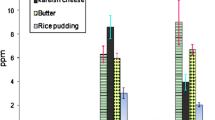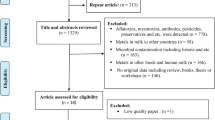Abstract
The objective of this study was to assess the contamination levels of arsenic (As), lead (Pb), chromium (Cr), and cadmium (Cd) in raw milk and the subsequent potential health risk to local consumers close to leather-processing plants in China. The As and Pb concentrations in milk from contaminated areas were 0.43 ± 0.21 and 2.86 ± 0.96 μg/L, respectively, which were significantly higher than in milk from unpolluted farm, with values of 0.20 ± 0.05 and 2.32 ± 0.78 μg/L, respectively. The Cr and Cd levels in milk from contaminated areas were 1.21 ± 1.57 and 0.15 ± 0.04 μg/L, respectively, which were slightly higher than in milk from unpolluted farm, with values of 0.87 ± 0.61 and 0.13 ± 0.04 μg/L, respectively, (P > 0.05). Target hazard quotient (THQ) and hazard index (HI) values for As, Pb, Cr, and Cd from milk consumption were calculated for individuals aged 3 to 69. The THQ followed a descending order of As > Pb > Cr > Cd, with values of 0.0066–0.0441, 0.0033–0.0220, 0.0019–0.0124, and 0.0007–0.0046, respectively. The HI values (0.0124–0.0832) were far below the threshold of 1.


Similar content being viewed by others
References
Hashemi M, Sadeghi A, Saghi M et al (2019) Health risk assessment for human exposure to trace metals and arsenic via consumption of hen egg collected from largest poultry industry in Iran. Biol Trace Elem Res 188:485–493. https://doi.org/10.1007/s12011-018-1437-4
EFSA (2010) Scientific opinion on lead in food. Eur Food Saf Auth 8. https://doi.org/10.2903/j.efsa.2010.1570
EFSA (2014) Scientific opinion on the risks to public health related to the presence of chromium in food and drinking water. EFSA J 12. https://doi.org/10.2903/j.efsa.2014.3595
JECFA (2011) Safety evaluation of certain food additives and contaminants, Seventy-third meeting of the Joint FAO/ WHO Expert Committee on Food Additives, Cadmium. Geneva, Switzerland
JECFA (2011) Safety evaluation of certain contaminants in food. Seventy-second meeting of the Joint FAO/ WHO Expert Committee on Food Additives, Arsenic, Geneva, Switzerland
ATSDR (2020) The Agency for Toxic Substances and Disease Registry’s 2019 substance priority list. Atlanta, America. https://www.atsdr.cdc.gov/spl/. Accessed 6 Nov 2020
Guerreiro TM, de Oliveira DN, Melo CFOR et al (2018) Evaluating the effects of the adulterants in milk using direct-infusion high-resolution mass spectrometry. Food Res Int 108:498–504. https://doi.org/10.1016/j.foodres.2018.03.079
Norouzirad R, González-Montaña JR, Martínez-Pastor F et al (2018) Lead and cadmium levels in raw bovine milk and dietary risk assessment in areas near petroleum extraction industries. Sci Total Environ 635:308–314. https://doi.org/10.1016/j.scitotenv.2018.04.138
National Health and Family Planning Commission, National Medical Products Administration of China (2017) Limits of contaminants in food. GB 2762-2017. https://www.cfsa.net.cn/Standard.aspx. Accessed 6 Nov 2020
González-Montaña JR, Senís E, Gutiérrez A, Prieto F (2012) Cadmium and lead in bovine milk in the mining area of the Caudal River (Spain). Environ Monit Assess 184:4029–4034. https://doi.org/10.1007/s10661-011-2241-1
McCawley P (1991) Book reviews. Econ Anal Policy 21:229–231. https://doi.org/10.1016/s0313-5926(91)50021-7
He ZL, Yang XE, Stoffella PJ (2005) Trace elements in agroecosystems and impacts on the environment. J Trace Elem Med Biol 19:125–140. https://doi.org/10.1016/j.jtemb.2005.02.010
Shengbang Z, Boxi H (2015) Heavy metal element pollution of cultivated vegetables in leather industrial zone by ICP-AES with Nimerlo Composite Index. 36:221–225. https://doi.org/10.7506/spkx1002-6630-201504044
Afzal M, Shabir G, Iqbal S et al (2014) Assessment of heavy metal contamination in soil and groundwater at leather industrial area of Kasur, Pakistan. Clean - Soil, Air, Water 42:1133–1139. https://doi.org/10.1002/clen.201100715
National Burea of Statistics of China (2002) National data. http://www.stats.gov.cn/tjsj/. Accessed 6 Nov 2020
Zhou X, Qu X, Zhao S et al (2017) Analysis of 22 elements in milk, feed, and water of dairy cow, goat, and buffalo from different regions of China. Biol Trace Elem Res 176:120–129. https://doi.org/10.1007/s12011-016-0819-8
Zhou X, Zheng N, Su C et al (2019) Relationships between Pb, As, Cr, and Cd in individual cows’ milk and milk composition and heavy metal contents in water, silage, and soil. Environ Pollut 255. https://doi.org/10.1016/j.envpol.2019.113322
International Programme on Chemical Safety (2009) Principles and methods for the risk assessment of chemicals in food. Environ Heal Criteria 240:1–34
General Adminastration of Sport of China (2015) National health monitoring bulletin of China in 2014. http://www.sport.gov.cn/n16/n1077/n1422/7331093.html. Accessed 6 Nov 2020
Chinese Society of Nutrition (2016) Chinese dietary guidelines 2016. People’s Medical Publishing House, Beijing, China
Khan K, Khan H, Lu Y et al (2014) Evaluation of toxicological risk of foodstuffs contaminated with heavy metals in Swat, Pakistan. Ecotoxicol Environ Saf 108:224–232. https://doi.org/10.1016/j.ecoenv.2014.05.014
Castro–González NP, Calderón–Sánchez F, Pérez–Sato M et al (2019) Health risk due to chronic heavy metal consumption via cow’s milk produced in Puebla, Mexico, in irrigated wastewater areas. Food Addit Contam Part B Surveill 12:38–44. https://doi.org/10.1080/19393210.2018.1520742
United States Environmental Protection Agency (1998) Chromium (VI). Washington, DC. https://www.epa.gov. Accessed 6 Nov 2020
United States Environmental Protection Agency (1989) Cadmium. Washington, DC. https://www.epa.gov. Accessed 6 Nov 2020
United States Environmental Protection Agency (1995) Mercury. Washington, DC. https://www.epa.gov. Accessed 6 Nov 2020
United States Environmental Protection Agency (1991) Arsenic (inorganic). Washington, DC. https://www.epa.gov. Accessed 6 Nov 2020
Castro Gonzalez NP, Moreno-Rojas R, Calderón Sánchez F et al (2017) Assessment risk to children’s health due to consumption of cow’s milk in polluted areas in Puebla and Tlaxcala, Mexico. Food Addit Contam Part B Surveill 10:200–207. https://doi.org/10.1080/19393210.2017.1316320
Codex Alimentarius Commission (2019) General standard for contaminants and toxins in food and feed. CXS193-1995 amended in 2019, PP1–66. http://www.fao.org/fao-who-codexalimentarius/codex-texts/list-standards/en/. Accessed 6 Nov 2020
European Commission (2006) Regulation (EC) No 1881/2006 of 19 December 2006 setting maximum levels for certain contaminants in foodstuffs. Off J Eur Union L364:1–35
Ran J, Wang D, Wang C et al (2016) Heavy metal contents, distribution, and prediction in a regional soil-wheat system. Sci Total Environ 544:422–431. https://doi.org/10.1016/j.scitotenv.2015.11.105
Simsek O, Gültekin R, Öksüz O, Kurultay S (2000) The effect of environmental pollution on the heavy metal content of raw milk. Nahrung – Food 44:360–363. https://doi.org/10.1002/1521-3803(20001001)44:5<360::AID-FOOD360>3.0.CO;2-G
Singh N, Pandey V, Misra J et al (1997) Atmospheric lead pollution from vehicular emissions - measurements in plants, soil and milk samples. Environ Monit Assess 45:9–19. https://doi.org/10.1023/A:1005700629967
Swarup D, Patra RC, Naresh R et al (2005) Blood lead levels in lactating cows reared around polluted localities; transfer of lead into milk. Sci Total Environ 349:67–71. https://doi.org/10.1016/j.scitotenv.2004.12.079
Tahir M, Iqbal M, Abbas M et al (2017) Comparative study of heavy metals distribution in soil, forage, blood and milk. Acta Ecol Sin 37:207–212. https://doi.org/10.1016/j.chnaes.2016.10.007
Singh A, Sharma RK, Agrawal M, Marshall FM (2010) Health risk assessment of heavy metals via dietary intake of foodstuffs from the wastewater irrigated site of a dry tropical area of India. Food Chem Toxicol 48:611–619. https://doi.org/10.1016/j.fct.2009.11.041
Bakary I, Yao KM, Etchian OA et al (2015) Zinc, copper, cadmium, and lead concentrations in water, sediment, and Anadara senilis in a tropical estuary. Environ Monit Assess 187:1–11. https://doi.org/10.1007/s10661-015-4976-6
Gabryszuk M, Słoniewski K, Sakowski T (2008) Macro- and microelements in milk and hair of cows from conventional vs. organic farms. Anim Sci Pap Reports 26:199–209. https://doi.org/10.1016/j.anifeedsci.2007.01.017
Zhou X (2019) Contamination of heavy metals in raw cow milk and the relationships between heavy metals in milk with heavy metals in water, silage and soil. Dissertation, University of Liège
Ministry of Ecology and Environment of the People’s Republic of China (2018) Soil environmental quality risk control standard for soil contamination of agricultural land. GB 15618-2018. http://www.mee.gov.cn/ywgz/fgbz/bz/bzwb/trhj/201807/t20180703_446029.shtml. Accessed 6 Nov 2020
Ministry of Health of the People’s Republic of China, Standardization administration (2006) GB5749-2006. http://openstd.samr.gov.cn/bzgk/gb/index. Accessed 6 Nov 2020
General Administration of Quality Supervision, Inspection and Quarantine of the People’s Republic of China, Standardization administration (2017) Hygienical standard for feeds. GB 13078-2017. http://openstd.samr.gov.cn/bzgk/gb/index. Accessed 6 Nov 2020
Zhou X, Qu X, Zheng N et al (2019) Large scale study of the within and between spatial variability of lead, arsenic, and cadmium contamination of cow milk in China. Sci Total Environ 650:3054–3061. https://doi.org/10.1016/j.scitotenv.2018.09.094
Koyuncu M, Alwazeer D (2019) Determination of trace elements, heavy metals, and antimony in polyethylene terephthalate–bottled local raw cow milk of Iğdır region in Turkey. Environ Monit Assess 191:666. https://doi.org/10.1007/s10661-019-7851-z
Erdogan S, Celik S, Erdogan Z (2004) Comparison of selected toxic elements in cow serum and milk samples from industrial and rural regions. Bull Environ Contam Toxicol 72:931–936. https://doi.org/10.1007/s00128-004-0333-0
Castro-González NP, Calderón-Sánchez F, Castro de Jesús J et al (2018) Heavy metals in cow’s milk and cheese produced in areas irrigated with waste water in Puebla, Mexico. Food Addit Contam Part B Surveill 11:33–36. https://doi.org/10.1080/19393210.2017.1397060
Arianejad M, Alizadeh M, Bahrami A, Arefhoseini SR (2015) Levels of some heavy metals in raw cow’s milk from selected milk production sites in Iran: is there any health concern? Health Promot Perspect 5:176–182. https://doi.org/10.15171/hpp.2015.021
Sobhanardakani S (2018) Human health risk assessment of Cd, Cu, Pb and Zn through consumption of raw and pasteurized cow’s milk. Iran J Public Health 47:1172–1180
Bilandžić N, Sedak M, Čalopek B et al (2016) Lead concentrations in raw cow and goat milk collected in rural areas of Croatia from 2010 to 2014. Bull Environ Contam Toxicol 96:645–649. https://doi.org/10.1007/s00128-016-1749-z
Meshref AMS, Moselhy WA, Hassan NEHY (2014) Heavy metals and trace elements levels in milk and milk products. J Food Meas Charact 8:381–388. https://doi.org/10.1007/s11694-014-9203-6
Sola-Larrañaga C, Navarro-Blasco I (2009) Chemometric analysis of minerals and trace elements in raw cow milk from the community of Navarra, Spain. Food Chem 112:189–196. https://doi.org/10.1016/j.foodchem.2008.05.062
Najarnezhad V, Akbarabadi M (2013) Heavy metals in raw cow and ewe milk from north-east Iran. Food Addit Contam Part B Surveill 6:158–162. https://doi.org/10.1080/19393210.2013.777799
Rubio MR, Sigrist ME, Encinas T et al (1998) Cadmium and lead levels in cow’s milk from a milking region in Santa Fe, Argentine. Bull Environ Contam Toxicol 60:164–167. https://doi.org/10.1007/s001289900605
Khan N, Jeong IS, Hwang IM et al (2014) Analysis of minor and trace elements in milk and yogurts by inductively coupled plasma-mass spectrometry (ICP-MS). Food Chem 147:220–224. https://doi.org/10.1016/j.foodchem.2013.09.147
Funding
This research was supported by the Risk Assessment of Environmental Pollutants in Raw Milk project (GJFP2019026), the Agricultural Science and Technology Innovation Program (ASTIP-IAS12), and the Modern Agro-Industry Technology Research System of the PR China (CARS-36).
Author information
Authors and Affiliations
Contributions
Xueyin Qu, Nan Zheng, and Jiaqi Wang conceived and designed the experiments; Chuanyou Su, Xueyin Qu, and Xuewei Zhou performed the experiments; Chuanyou Su and Huimin Liu analyzed the data and wrote the main text; Chuanyou Su, Yanan Gao, Huimin Liu, and Hongjian Yang revised the manuscript.
Corresponding author
Ethics declarations
All procedures performed in this study involving animals were in accordance with the ethical standards of Chinese Academy of Agricultural Sciences. An informed consent was obtained from the farms owners.
Conflict of Interest
The authors declare that they have no conflict of interest.
Additional information
Publisher’s Note
Springer Nature remains neutral with regard to jurisdictional claims in published maps and institutional affiliations.
Rights and permissions
About this article
Cite this article
Su, C., Liu, H., Qu, X. et al. Heavy Metals in Raw Milk and Dietary Exposure Assessment in the Vicinity of Leather-Processing Plants. Biol Trace Elem Res 199, 3303–3311 (2021). https://doi.org/10.1007/s12011-020-02470-8
Received:
Accepted:
Published:
Issue Date:
DOI: https://doi.org/10.1007/s12011-020-02470-8




